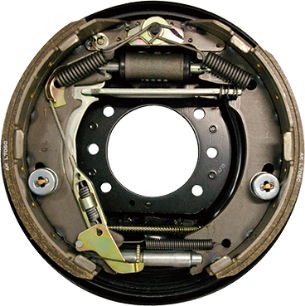Drum Brakes
Drum brakes have brake drums that rotate with the wheels.

Drum brakes have brake drums that rotate with the wheels.
Drum brakes have brake drums that rotate with the wheels.

Drum brakes have brake drums that rotate with the wheels.
Brake shoes fitted with brake linings (friction material) which press against the drums from the inside to generate braking force (decelerate and stop) are set inside of the drums.
With this system, friction is generated by pressing the brake linings against the inside surfaces of the drums. This friction converts kinetic energy into thermal energy. Drum rotation helps to press the shoes and the lining against the drum with more force, offering superior braking force in comparison with disc brakes. On the other hand, it is very important to design the components so that the heat from the thermal energy is dissipated efficiently into the atmosphere.
There are three types of drum brakes depending on how the brake shoes are pressed on to the drums; leading/trailing shoe type, twin leading shoe type and duo-servo type.
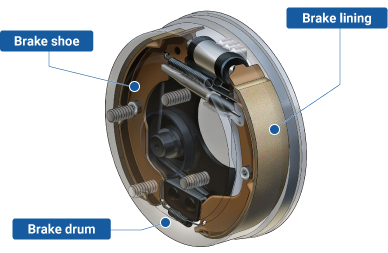
Drum brakes are a brake system with brake drums (rotor) which rotate with the wheels. Inside each drum are brake shoes fitted with brake linings (friction material). Pistons (pressure mechanism) press against the drums from the inside to generate braking force, thus making is possible to decelerate and stop the vehicle.
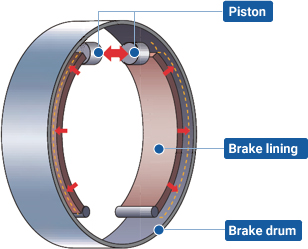
When the driver steps on the brake pedal, the power is amplified by the brake booster (servo system) and changed into hydraulic pressure (oil-pressure) by the master cylinder. The pressure reaches the brakes on the wheels via tubing filled with brake oil (brake fluid). The delivered pressure pushes the pistons on the brakes of the four wheels. The pistons press the brake linings, which are friction materials, against the inside surfaces of the brake drums which rotate with the wheels. The linings are pressed on the rotating drums, which in turn decelerate the wheels, thereby slowing down and stopping the vehicle.
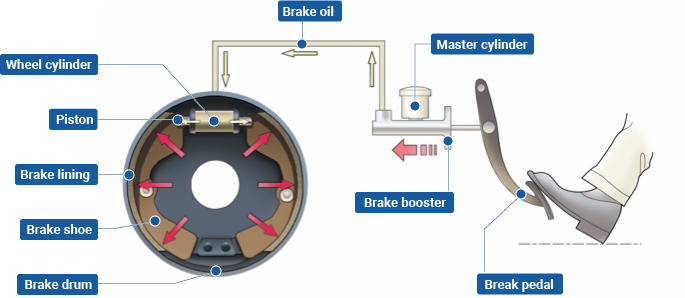
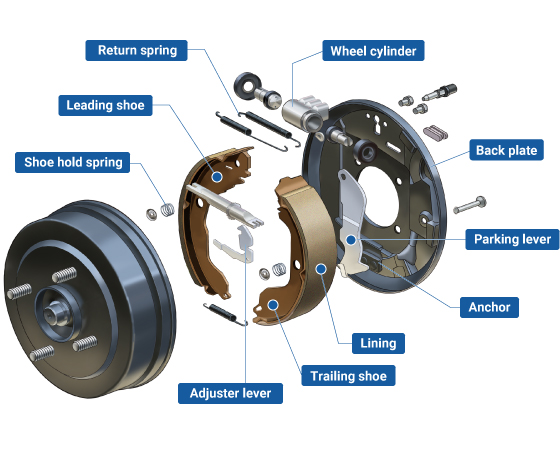
"Leading (or primary) shoe" is a term referring to the shoe that moves in the direction of rotation when it is being pressed against the drum. The other shoe is called the “trailing (secondary) shoe.” The leading shoe is pressed in the same direction as the rotation of the drums, and this rotation helps to press the shoes against the drum with greater pressure for stronger braking force. This is called the servo effect (self-boosting effect) which realizes the powerful braking forces of drum brakes.
Structurally, it has a wheel cylinder housing a piston with which hydraulic pressure is generated to push the two shoes against the drum’s inner surface.
The two shoes function in a way they both become either the trailing shoe or leading shoe depending on whether the vehicle is travelling forward or backward. Drum brakes generate consistent braking force whether the vehicle travels forward or backward. This is because drum brakes generate the same braking force in either direction. Generally, this type is used for the rear brakes of passenger cars.
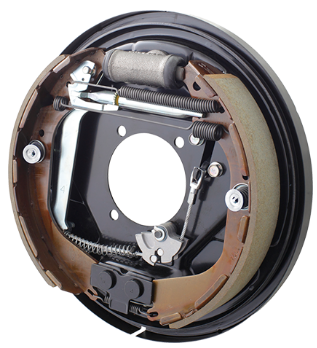
This type of drum brake has two wheel cylinders and two leading shoes. Each wheel cylinder presses on one shoe, so that both shoes act as leading ones when the vehicle moves forward, providing superior braking force.
Each of the pistons housed in the wheel cylinders displace in one direction, so when the vehicle is in reverse both shoes act as trailing ones. This type is used mainly for the front brakes of small-to-mid-sized trucks.
The dual twin leading shoe type has pistons that displace in both directions, making it possible for both shoes to act as leading ones, regardless of direction of travel. This type is mainly used for the rear brakes of small-to-mid-sized trucks.
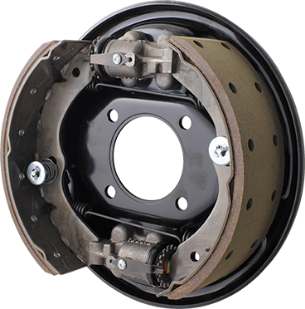
The duo servo type features a structure where two brake shoes, called the primary shoe and secondary shoe, are linked via an adjuster.Strong pressure from the servo effect (self-boosting effect) of the primary shoe is transmitted to the linked secondary shoe, thus generated a very large braking force.
This type is mainly used for parking brakes on passenger cars, the center brakes on trucks, and brakes on forklifts.
